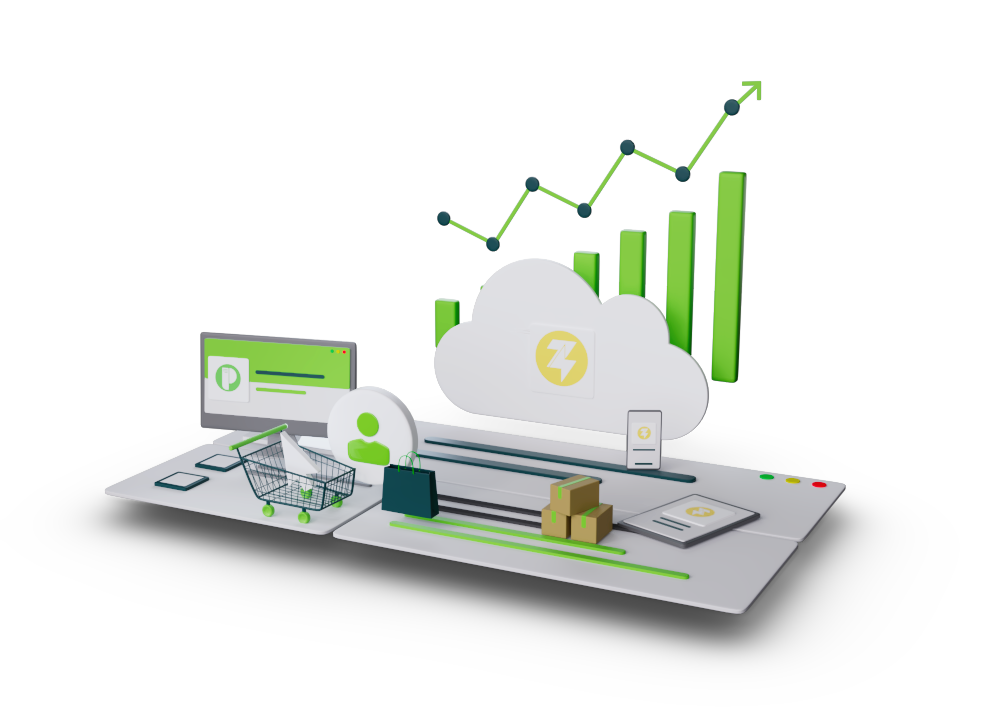How the Ginesys One Suite is Being Rebuilt Using Microservices and AI
The retail industry is dynamic, with technology playing a central role in shaping how businesses operate, adapt, and grow. From consumer expectations to backend logistics, every aspect of retail now demands greater speed and accuracy. Traditional retail management systems, built on monolithic architectures, have long struggled to keep up with these shifts. They often lack flexibility and make it difficult for retailers to integrate new technologies, scale operations efficiently, or leverage real-time data for decision-making.
Retailers today are looking beyond conventional systems at modern, scalable, and intelligent solutions. Ginesys One, a comprehensive retail omnichannel suite built for the entire retail value chain, is undergoing a strategic transformation to meet these needs. By shifting from standalone, siloed products to a unified, microservices-based platform powered by AI-driven automation, it will enable retailers to manage their operations with greater agility, optimize customer experiences, and make real-time, data-backed decisions.
In this blog, we’ll take a deep dive into how Ginesys One’s architectural modernization is driving a next-generation retail ecosystem—one that is scalable, resilient, and primed for innovation.
The Challenges of Traditional Retail Management Systems
Traditional retail management systems have long served as the backbone of retail operations. However, as consumer expectations rise and shopping behaviour shift, retailers relying on outdated systems find themselves struggling to keep up. From fragmented data to slow system updates, traditional platforms present several challenges that prevent retailers from delivering efficient retail experiences.
The key roadblocks that retailers face with conventional retail management systems include:
- Siloed Systems and Data Fragmentation
Retailers using multiple disconnected software tools such as ERP, POS, and OMS often face inefficiencies due to a lack of real-time data synchronization. This generates inconsistent inventory data and leads to inefficient order processing.
- Scalability Issues
Legacy retail management systems struggle to handle peak demand during major sales, festivals, or flash sales. Retailers experience slow response times, website crashes, and disruptions in order fulfilment.
- Limited Updates
Monolithic architectures make it difficult to update or customize specific functionalities without overhauling the entire system. This rigidity prevents retailers from quickly adapting to shifting consumer behaviour and market trends.
- Slow Innovation Cycle
Deploying new features in traditional retail systems takes time, which delays the retailer’s ability to offer innovative solutions like AI-driven personalization, dynamic pricing, and omnichannel integration.

Scale your operations with Ginesys One’s next-gen retail management platform.
Microservices in Retail Tech: Reshaping Modern Retail Systems
What Are Microservices?
Microservices architecture is a modern software development approach that structures an application as a collection of loosely coupled, independently deployable services. Unlike traditional monolithic systems, where all functionalities are tightly integrated into a single codebase, microservices break down the system into smaller, self-contained units that each handle a specific business function.
In the context of retail, these microservices could include inventory management, checkout, order processing, customer relationship management, and analytics, each operating as an independent service with its own database and logic.
How It Benefits Retailers
- Scalability: Each microservice can be scaled independently based on demand, allowing retailers to handle peak traffic surges during sales events without system slowdowns.
- Fault Isolation: If one service encounters an issue, it remains localized and does not bring down the entire system, ensuring high availability and uninterrupted retail operations.
- Faster Deployment: New features, updates, or bug fixes can be deployed to individual services without requiring downtime for the entire platform, accelerating innovation and agility.
- Enhanced Security: Isolated services limit the impact of security breaches, making it easier to implement and enforce compliance with industry regulations like Data Privacy laws and security for payments.
- Improved Performance: By distributing workloads across multiple independent services, microservices reduce system bottlenecks, leading to faster response times and exceptional customer experiences.
- Smoother Integrations: Retailers can easily integrate third-party applications such as payment gateways, marketing automation tools, and CRM systems without disrupting core functionalities.
- Better Customization: Businesses can tailor specific services to their needs without overhauling the entire platform, making it easier to adapt to trends and operational shifts.
- Cost Efficiency: Optimized resource utilization means businesses only scale the services they need, reducing infrastructure costs compared to monolithic systems that require scaling the entire application.
- Omnichannel Readiness: Microservices architecture enables effortless synchronization between online and offline sales channels, ensuring real-time inventory updates, unified customer data, and consistent shopping experiences.

Deliver flawless omnichannel experiences with real-time data synchronization across POS, ERP, and OMS.
Ginesys One: From Standalone Products to a Unified Retail Platform
Ginesys One is addressing operational challenges by integrating Ginesys ERP, Zwing and Ginesys POS, and Browntape OMS into a single, cohesive retail management platform powered by a microservices-based architecture. This transition ensures real-time data flow across all retail functions, empowering businesses to make decisions with accurate, up-to-the-minute insights.
The microservices approach also strengthens B2B and B2C order fulfilment, supporting omnichannel capabilities such as endless aisle, click & collect, and real-time inventory synchronization. Retailers can simplify omnichannel experiences, allowing customers to browse, purchase, and receive products through multiple touchpoints without friction.
The Before: Ginesys One’s Legacy Monolithic Architecture
Ginesys One initially operated on a monolithic architecture, with key retail solutions functioning as separate yet interconnected systems. While these systems provided comprehensive retail management, their structure posed challenges in scalability, flexibility, and integration.
- Ginesys ERP and POS served as the backbone of retail operations, encompassing Warehouse Management (WMS), Inventory Management, Procurement, Sales & Distribution, Finance, Production, Retail Management, Desktop POS, and Operational Reporting. However, its monolithic nature made modular upgrades and third-party integrations difficult.
- Zwing POS offered a cloud-based, flexible POS system for mobile and web, covering Billing, Cash Management, Promotions, Inventory, and Store User Management. Despite its agility, integrating it within a monolithic ecosystem limited its adaptability.
- Browntape specialized in e-commerce order management, supporting Order Processing, Multi-Channel Inventory, Omni-Channel Fulfilment, Returns, and Reconciliation. The lack of a microservices-based approach, however, restricted rapid scaling.
- EaseMyRetail Integration Platform bridged different retail systems yet was constrained by the monolithic backend.
- Business Intelligence (powered by Qlik) delivered analytics and data visualization but lacked real-time insights due to the traditional architecture.

Key Features of Ginesys One’s Microservices-Based Architecture
The growing complexity of omnichannel retail demanded higher scalability, faster deployment and stronger security measures. To address these challenges, Ginesys One is transitioning into a microservices-based architecture.
- Resilient and Fault-Tolerant System
- Independent services ensure that system failures are localized, preventing complete breakdowns.
- Built-in real-time backups minimize data loss and ensure fast recovery in case of failures.
- Scalability for High-Traffic Retail Events
- Retailers experience 5x traffic load during peak sales periods, requiring robust scalability.
- Services auto-scale based on traffic spikes, avoiding system slowdowns and ensuring smooth performance.
- Faster Innovation and Deployment
- Developers can release updates to individual services without affecting the entire system.
- New features are deployed faster, enabling retailers to adapt quickly to changing market demands.
- Enhanced Monitoring and Security
- Active service monitoring ensures quick alerts and actions to prevent business interruptions.
- Advanced security measures protect customer data and transactions, ensuring compliance with industry regulations.
Key Developments in Ginesys One’s Integrated Suite with Microservices
Ginesys One’s transition to a microservices-based architecture isn’t just about scalability and resilience—it’s a strategic re-engineering of core systems to enable smoother retail operations. Here’s how its key components have evolved:
- ERP Core System & Desktop POS (GPOS)
- The core ERP and GPOS systems retain a monolithic structure to ensure data consistency and a unified user experience.
- However, these modules are now being transitioned to multi-tenancy, with enhanced data archival strategies to improve performance.
- Order Management System (BT-OMS)
- The OMS continues as a separate module but is being re-architected with enterprise-specific databases.
- A dedicated Inventory sub-system is introduced, leveraging an asynchronous Kafka layer for seamless integration.
- WebPOS/MPOS (Zwing POS)
- Some customer management functionalities are extracted into a standalone service, refining the POS system’s focus.
- Migrated to a common cloud, ensuring smoother integration with G1 Omni services.
- G1 Customer Omni Services
- A new microservice consolidates Customer Management, Loyalty, Gift Vouchers, Wallets, and Notifications.
- This ensures a consistent customer experience across all POS systems.
- Enterprise Onboarding & Single Sign-On (SSO)
- A centralized authentication system simplifies user access and enhances security across Ginesys One.
- Ginesys Data Lake House
- A common data lake house aggregates data from multiple sources for advanced analytics in near real-time.
- The reporting and analytics for all the products will move to this common Data Lake House and the reporting app will be InsightX.
- Future roadmap includes a Customer Data Platform (CDP) for a 360-degree customer view.
- Ginesys BI
- All reporting services are now centralized, with a unified business intelligence (BI) layer for deeper insights.
- Ginesys Data Integration Platform
- Built on an asynchronous eventing framework, this platform ensures easy data exchange between Ginesys One modules and external systems.
- Ginesys Notification Service
- A centralized communication hub for managing notifications across multiple channels.

Simplify multi-store management and sync inventory across locations with Ginesys Cloud POS.
Access Retail Insights with Ginesys One’s Data Lakehouse
What is a Data Lakehouse?
A data lakehouse combines the best features of traditional data warehouses and modern data lakes. It provides the structured querying capabilities of a warehouse while maintaining the flexibility and scalability of a data lake, enabling businesses to process both structured and unstructured data efficiently.
This hybrid approach supports real-time analytics, AI-driven insights, and data integration, making it ideal for retailers handling vast amounts of transaction, inventory, and customer data.
Ginesys One’s Unified Retail Data Engine
Ginesys One’s data lakehouse is a centralized data repository (lakehouse) that integrates real-time inputs from POS (desktop, web, mobile), multi-channel OMS, and ERP, ensuring a consistent flow of retail data.
- Real-Time Insights for Smarter Decision-Making
With continuous data synchronization, retailers gain instant visibility into inventory movement, customer preferences, and sales trends. This enables proactive decision-making, reducing stockouts and improving demand forecasting. - Powering Ginesys InsightX for Advanced BI
This fuels InsightX, an advanced business intelligence and reporting system, delivering comprehensive analytics on sales performance, customer behaviour, and operational efficiency. Retailers can access interactive dashboards and AI-driven recommendations to refine their strategies. - AI-Driven Retail Optimization
Leveraging machine learning and predictive analytics, DataX helps businesses automate stock replenishment, personalize marketing efforts, and enhance sales strategies. This ensures better inventory turnover, higher customer engagement, and increased profitability.
Enhancing Operational Efficiency in Retail with AI-Driven Automation
Ginesys One integrates AI-driven automation at multiple touchpoints to ensure real-time decision-making and proactive issue resolution for modern retail operations. Here’s how:
Predictive Analytics for Inventory Management
- AI algorithms analyse historical sales data, demand trends, seasonal variations, and external factors such as market conditions and regional buying behaviour to predict inventory requirements. This helps retailers maintain optimal stock levels and avoid unnecessary holding costs.
- Automated purchase recommendations adjust replenishment cycles based on real-time sales performance, ensuring that stock is refilled only when necessary, reducing over-purchasing and minimizing stockouts.
- AI-powered inventory classification categorizes products based on sales velocity, profitability, and customer demand, enabling retailers to allocate shelf space and warehouse resources more efficiently.
- Intelligent supply chain forecasting allows retailers to anticipate supplier lead times and logistics disruptions, ensuring proactive adjustments in procurement strategies.
AI-Powered Customer Engagement
- AI-driven recommendation engines analyse customer browsing patterns, purchase history, and engagement metrics to deliver hyper-personalized product suggestions, increasing conversion rates and basket sizes.
- Automated loyalty programs use AI to track customer preferences and spending habits, offering dynamic rewards, tier-based incentives, and customized discounts that enhance brand loyalty.
- AI-powered chatbots and virtual assistants provide 24/7 customer support, answering queries, handling order modifications, and making personalized product suggestions in real time.
- Sentiment analysis tools evaluate customer feedback from reviews, social media, and service interactions, enabling brands to refine their marketing strategies and improve customer experience.
Efficient Order Processing and Fulfilment
- AI-powered automation accelerates order routing and processing, reducing manual intervention in warehouses and ensuring faster fulfilment for both online and offline sales channels.
- Smart order prioritization analyses customer urgency, location, and stock availability to determine the most efficient fulfilment strategy, optimizing delivery times.
- Features like BOPIS (Buy Online, Pick Up In-Store) and Endless Aisle allow customers to shop beyond in-store inventory, ensuring seamless omnichannel shopping experiences.
- AI-driven logistics management optimizes delivery routes, shipping schedules, and carrier selection, reducing delivery delays and logistics costs.
- Automated returns management helps simplify reverse logistics, ensuring quick refunds or exchanges and improving post-purchase satisfaction.
Real-Time Alerts and Proactive Issue Resolution
- AI-powered monitoring continuously tracks stock levels, automatically triggering replenishment alerts when inventory falls below a set threshold.
- Automated fraud detection systems analyse transaction patterns and identify suspicious activities, preventing fraudulent orders and chargebacks.
- AI-driven supply chain alerts notify retailers about delayed shipments, warehouse inefficiencies, or potential disruptions, allowing them to take proactive measures to mitigate risks.
- Real-time operational health monitoring flags potential system failures or bottlenecks in retail operations, ensuring smooth day-to-day functioning with minimal downtime.

Stay tuned as we redefine what’s possible in retail technology.
The Big Picture: How Microservices and AI are Transforming Retail Globally
Microservices are redefining retail infrastructure, enabling brands like Amazon and Walmart to scale rapidly. In 2024, 69% of retailers reported an increase in annual revenue attributed to AI adoption, while 72% experienced a decrease in operating costs. Additionally, nearly 50% of retail respondents believe generative AI will be a market differentiator, revolutionizing customer experiences and marketing.
AI integration in retail is accelerating, with companies planning to increase investment in generative AI within the next year. This surge is evident as major retailers like Old Navy implement AI-driven systems to enhance inventory management and customer service.
Moreover, omnichannel retailing has become imperative, as consumers expect flexible shopping experiences across online and offline platforms. AI facilitates this by enabling personalized recommendations, dynamic pricing, and efficient inventory management. For instance, AI-powered demand forecasting helps fashion retailers optimize stock levels, reducing overstock and stockouts. During the 2024 holiday season, AI-influenced shopping contributed to a 4% increase in online sales in the U.S., demonstrating its growing impact on consumer behaviour. In fact, data-driven decision-making is at the forefront of retail transformation today.

Experience the future of unified retail management with Ginesys One.
The Future of Retail is Now with Ginesys One
Retail success today hinges on the ability to adapt, integrate, and optimize operations through technology. Ginesys empowers businesses with a comprehensive suite of solutions that go beyond basic automation—driving efficiency, enhancing customer experiences, and ensuring seamlessly connected omnichannel operations.
By leveraging AI-driven insights, cloud scalability, and deep ERP integrations, businesses can become more strategically advantageous. Whether it’s improving inventory accuracy, accelerating order fulfilment, or simplifying financial workflows, Ginesys One offers a future-ready retail technology stack, ensuring scalability, agility, and data-driven intelligence.
Turn every touchpoint into an opportunity with Ginesys—book a demo today.

